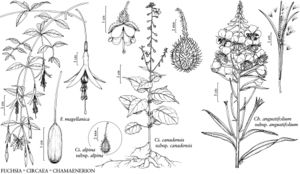Chamaenerion
Pl. Veron. 3: 168. 1754.
| Taxon | Illustrator ⠉ | |
|---|---|---|
 | Fuchsia magellanica Circaea canadensis subsp. canadensis Circaea alpina subsp. alpina Chamaenerion angustifolium subsp. angustifolium |
Herbs, perennial, often clumped, caulescent; from woody caudex or forming shoots from spreading rhizomes. Stems erect, usually unbranched, rarely sparsely branched, strigillose or glabrous. Leaves cauline, usually alternate, rarely subopposite or subverticillate in proximal pairs; subsessile; blades scalelike and minute below-ground, proximal blades small, coriaceous to submembranous, triangular-ovate to lanceolate, distal blades usually linear to lanceolate or elliptic, rarely ovate, often subcoriaceous. Inflorescences terminal, racemes [spikes], erect or suberect. Flowers bisexual, protandrous, slightly zygomorphic, opening on axis nearly perpendicular to stem axis, deciduous from ovary apex; floral-tube absent; sepals green or reddish green, spreading; petals spreading, usually rose-purple to pink, rarely white, margins entire; stamens subequal; filament bases slightly bulged proximally to form a chamber around nectary disc, initially erect, later deflexed; anthers versatile, pollen bluish gray [yellow], shed in monads, 3 (–5) -aperturate; ovary 4-locular, nectary disc raised on ovary apex; style initially deflexed, becoming erect 2–3 days after onset of anthesis, stigma deeply 4-lobed, lobes spreading open to revolute as style becomes erect, commissural, receptive only on inner surfaces, surface dry, with multicellular papillae. Fruit a capsule, loculicidal, spreading to erect, narrowly cylindrical, terete to quadrangular, splitting to base with intact central column; pedicellate. Seeds 200–500, in 1 row per locule, gray-brown, narrowly clavate, with ± persistent coma at chalazal end. = 18.
Distribution
North America, Mexico, Eurasia, nw Africa, Atlantic Islands (Iceland)
Discussion
Species 8 (2 in the flora).
J. Holub (1972b) argued that the correct name for this group, when segregated from Epilobium, should be Chamerion (Rafinesque) Rafinesque ex Holub. However, A. N. Sennikov (2011), using the more recent and clarified ICBN (Melbourne Code), correctly argued that the name of the segregated genus should be Chamaenerion, and that opinion is followed here.
All species of Chamaenerion tested to date have been self-compatible, although the strong protandry can result in low fertilization rates if there is a shortage of pollinators. Flowering is diurnal, with each flower generally remaining open for three to five or more days.
All eight species (nine taxa) of Chamaenerion are restricted to the northern hemisphere, and six of eight species occur only in Eurasia; Circaea is the only other genus of Onagraceae in which most species occur outside of the western hemisphere (D. E. Boufford 1982b). Chamaenerion is generally divided into two sections, each with four species (T. Tacik 1959; and, as Chamerion, J. Holub 1972b; W. L. Wagner et al. 2007). P. H. Raven (1976) and most others who treated this group as a section of Epilobium divided it into two corresponding subsections. Both species of Chamaenerion in North America are placed in sect. Chamaenerion (not treated formerly here), along with two species endemic to the Himalayan region, C. conspersum (Haussknecht) Kitamura and C. speciosum (Decaisne) Hoch & Gandhi (Chen C. J. et al. 1992); the other four species, all endemic in Eurasia, comprise sect. Rosmarinifolium Tacik.
Chamaenerion differs from Epilobium in leaves nearly always alternate, rarely subopposite or verticillate near stem base (versus opposite at least on proximal stem); absence of a floral tube (versus a distinct floral tube); slightly zygomorphic flowers with subequal stamens that are erect, later deflexed, and a style that is deflexed, later erect (versus actinomorphic flowers with erect stamens in two unequal series and erect style); and pollen shed in monads (versus pollen shed in tetrads, or monads in one species). Molecular analyses (D. A. Baum et al. 1994; R. A. Levin et al. 2004) provided strong support for Chamaenerion as a monophyletic group separate from Epilobium, and for sect. Chamaenerion (only C. angustifolium and C. latifolium sampled) as monophyletic.
The superfluous and illegitimate name Pyrogennema Lunell pertains here.
Selected References
None.
Lower Taxa
Key
| 1 | Leaf blades elliptic or ovate to lanceolate-elliptic, 2–5(–8) × 0.6–1.7(–2) cm, without submarginal vein, petioles 0–2 mm; bracts ca. 1/2 as long as cauline leaves; seeds fusiform, 1.2–2.1 × 0.4–0.6 mm, with distinct chalazal collar (0.1–0.2 mm); styles glabrous, shorter than stamens. | Chamaenerion latifolium |
| 1 | Leaf blades lanceolate to linear, proximally oblong to obovate, (3–)5–23 × 0.3–3.4 cm, with ± prominent submarginal vein, petioles 0–7 mm; bracts much smaller than cauline leaves; seeds narrowly obovoid to oblong, 0.9–1.3 × 0.3–0.4 mm, with inconspicuous chalazal collar (to 0.1 mm); styles pubescent proximally, longer than stamens. | Chamaenerion angustifolium |